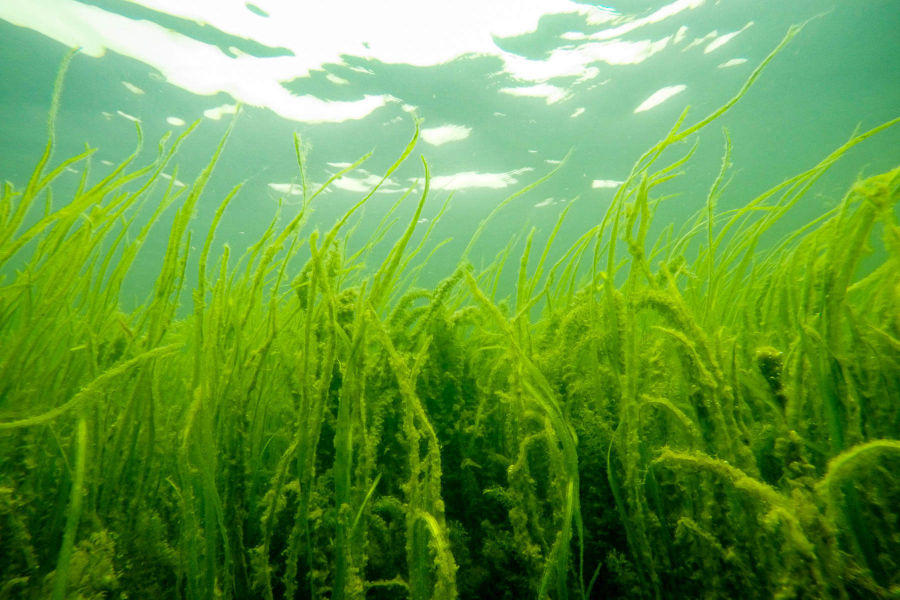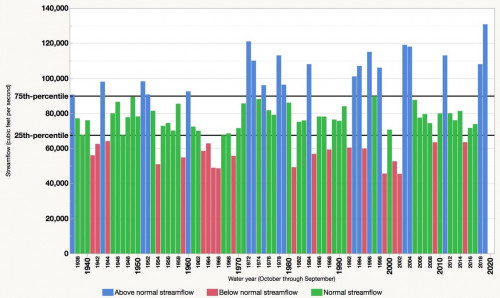Bay health impacted by record flows
Largest amount of fresh water to enter the Chesapeake Bay since 1937

In 2019, more fresh water flowed into the Chesapeake Bay than in any of the past 82 years. According to the U.S. Geological Survey, the average freshwater streamflow into the Bay over the past year was 130,750 cubic feet per second—the highest since data collection began in 1937. To put this into perspective, 130,750 cubic feet is about 978,077 gallons. In comparison, an average Olympic-sized swimming pool holds approximately 660,253 gallons of water. That’s more than one pool entering the Bay every second!
These historic flows, which followed the record-breaking rainfall seen in 2018, caused Bay-wide changes in salinity. The extreme rainfall also washed nutrient and sediment pollution into the Bay, which depleted dissolved oxygen that aquatic species depend on for survival, and dramatically impacted the Bay’s underwater grass habitat and other living resources.

Salinity levels at near-historic lows
The Chesapeake Bay is an estuary: a body of water in which fresh and saltwater mix. Since the Bay receives freshwater from its rivers, mainly the Susquehanna and the Potomac, and saltwater from the Atlantic Ocean in the south, salinity levels vary by location. In general, Bay waters in the north are fresher and become saltier as you head south.
However, the extreme amounts of rain that led to these heavy flows of freshwater between 2018 and 2019 dramatically impacted salinity levels throughout the entire Bay. Beginning in May 2018, salinity levels in the middle of the Chesapeake Bay were below-average, a situation which persisted for 17 consecutive months. A record-low level of salinity was observed in February 2019 in this area, and the months that followed continued to hover near record-low levels.
As of October 2019, waters in the lower Bay have returned to their normal salinity levels. However, the months of high flows has dramatically impacted plant and animal life in these regions. This has impacted the habitat for spawning fish, the distribution of underwater grasses and oysters, and increased the presence of Dermo and MSX, which are oyster-killing parasites.

After a promising year, underwater grasses have taken a step back
One of the most severely impacted resources this year was the Bay’s underwater grasses—also called submerged aquatic vegetation (SAV). In 2018, an estimated 91,559 acres of underwater grasses were mapped. Underwater grasses are measured each year by an aerial survey. However, in 2018, weather conditions and air-space restrictions prevented researchers from successfully collecting aerial imagery in 22% of the monitored area. Taking into account the unmapped area, experts estimated that underwater grasses might have covered as much as 108,960 acres.
Initial surveys in 2019 indicate that the freshwater flows—and the pollution that it brings with it—may have been detrimental to many species of underwater grasses. Although acreage data is not yet available, it is likely that 2019 SAV will be below the 2017 target of 90,000 acres.
“The flows have made it a particularly rough year for underwater grasses,” said Brooke Landry, a biologist at the Maryland Department of Natural Resources and chair of the Chesapeake Bay Program’s SAV Workgroup. “While we’re still analyzing the data, the general expectation is that underwater grasses will take a pretty big step backwards, especially in areas where there wasn’t a lot of diversity.”
The high flows, along with high temperatures, proved especially problematic for eelgrass, a cool-water species of underwater grass which only grows in the Bay’s saltier waters and provides important foraging habitat for the Bay’s blue crabs. “Potentially thousands of acres of eelgrass could be lost in the lower Bay,” said Landry. “Eelgrass isn’t reproductive until it’s two years old. So, when you have two consecutive years of heavy freshwater flows – as well as heat events causing multiple stressors- eelgrass seedlings don’t have the chance to establish themselves, develop or reproduce. The result is that we might see a significant loss of eelgrass.”
However, Landry expects the Bay’s more resilient underwater grass species to rebound from the year of high flows. “We hope to see widgeon grass bounce back and take the place of eelgrass in the lower Bay,” said Landry. “There’s a hope among experts that widgeon grass will provide the same benefits to the ecosystem that eelgrass does, and that eelgrass will eventually recover as well, but only time will tell.”
Underwater grasses play an invaluable role in the Bay watershed. “I like to think of Bay grass as the quintessential indicator of Bay health,” said Peter Tango, monitoring coordinator for the Chesapeake Bay Program. “The healthier our grasses are, the healthier the Bay is overall.”
Oysters restoration heavily impaired in upper Bay
In 2018, the Maryland Oyster Population Status Report found that oyster populations were particularly depleted in the upper Chesapeake Bay and its tributaries, where the freshwater flows had the most impact. They were especially severe in the Potomac River, where 88% to 100% of oysters did not survive.
Oysters play an important role in keeping the Bay healthy. Just one adult oyster can filter 50 gallons of water in a day, improving water quality by removing excess plankton, algae and nutrient pollutants from Bay waters. However, experts are worried that the deluge of freshwater, and the pollution that comes along, could smother reefs and suffocate oysters.
“Oysters don’t have an extensive ability to survive in fresh or polluted waters,” said Tango. Even slight shifts in salinity or water quality can have profound consequences on oysters’ health, inhibiting their reproduction, disrupting their ability to feed and slowing down their growth.
Blue crab populations are improving
While oyster populations have struggled in the adverse conditions, blue crabs have fared significantly better. Blue crabs can tolerate fresher water systems better than oysters, and also have the option to migrate to areas where conditions are more favorable.
The 2019 Blue Crab Advisory Report found that the overall Chesapeake Bay blue crab population increased nearly 60%, from 372 million in 2018 to 594 million in 2019. Results of the survey also show that the Bay’s total adult female blue crab population has increased nearly 30% to 191 million—well above the abundance threshold of 70 million crabs. The report is an encouraging sign to many experts who were concerned about the impact 2018’s heavy rainfall would have on blue crab populations.
While blue crab populations are increasing overall, it appears they are moving. “Fisheries are reporting less blue crabs being caught in the upper-Bay than in years before,” said Tango. “What’s likely happening is that the freshwater flows are driving blue crabs further south.”
While there is reason to be optimistic, we won’t know the full extent of the impact from 2019’s freshwater flows until this year’s winter dredge survey is complete in Maryland and Virginia.
Invasive species are taking advantage of increased freshwater flows
While much of the Bay’s native life struggles to adapt to the heightened freshwater flows and the associated nutrient and sediment pollution, the Bay’s invasive species are taking advantage of the changing conditions.
“When salinity levels are low, new freshwater migration paths open up and more of the Bay becomes available to invasive species,” said Tango. “Certain species will do abundantly well because they have more habitat in certain salinities.”
One such species is the blue catfish. Blue catfish, which can grow up to five feet long and over 100 pounds, are a disruptive force in the Bay ecosystem. They uproot underwater vegetation, outcompete native species for food and prey on species such as blue crabs, yellow perch and white catfish.
“With two consecutive years of lower-than-average salinity levels, blue catfish were able to easily spread to new freshwater tributaries throughout the Bay and establish new populations,” said Tango. “Today, blue catfish are more widely distributed than perhaps ever.”
Dead zones continue to grow
A dead zone is an area of little to no dissolved oxygen that forms when nutrient-fueled algae blooms die and decompose. The decomposition process depletes oxygen levels in surrounding waters faster than it can be replenished, and the resulting low-oxygen conditions can suffocate the Bay’s marine life such as blue crabs, oysters and fish.
At the beginning of the summer, experts predicted the largest dead zone in decades, estimating it would cover about 2.1 cubic miles—about 50% larger than the long-term average.
In its annual Dead Zone Report Card, the Virginia Institute for Marine Science reported that the summer’s dead zones fell just shy of predictions, peaking at 2.01 cubic miles in late July before rapidly decreasing in August and early September. Overall, the hypoxic volume—areas with less than two milligrams per liter—in 2019 was up 28% compared to 2018.
“This year, we saw the third-lowest dissolved oxygen levels ever recorded in the watershed,” said Scott Phillips, U.S. Geological Survey Chesapeake Bay Coordinator, citing monitoring data collected by the Maryland Department of Natural Resources. “With back-to-back years of high rainfall and freshwater flows, the Bay isn’t being given a chance to recover.
The U.S. Geological Survey estimated that in spring 2019, the Susquehanna River delivered 102.6 million pounds of nitrogen into the Chesapeake Bay, while the Potomac River supplied an additional 47.7 million pounds of nitrogen. This is well above long-term averages of 80.6 million pounds from the Susquehanna and 31.8 million pounds from the Potomac. Loads from the Susquehanna have not been this high since 2011.
Warmer waters resulting from climate change may also be playing a role in the size of the Bay’s dead zone, further aggravating the problem. “Oxygen solubility declines with increasing water temperatures,” said Tango. “As the Bay continues to warm, we can expect the water to hold less oxygen and for dead zones to increase in size.”
Measuring the impacts
The Chesapeake Bay is a vast, complex estuary that responds differently to high freshwater flows. Because of the unprecedented nature of this year’s flows, their long-term impact remains to be seen.
It is not clear yet whether the last two years of record rainfall and historic flows are an anomaly, or if they represent the beginning of a pattern resulting from climate change. As we look to the future, the Chesapeake Bay Program’s water quality monitoring partnership—and its established history of data—is more important than ever.

Comments
There are no comments.
Thank you!
Your comment has been received. Before it can be published, the comment will be reviewed by our team to ensure it adheres with our rules of engagement.
Back to recent stories